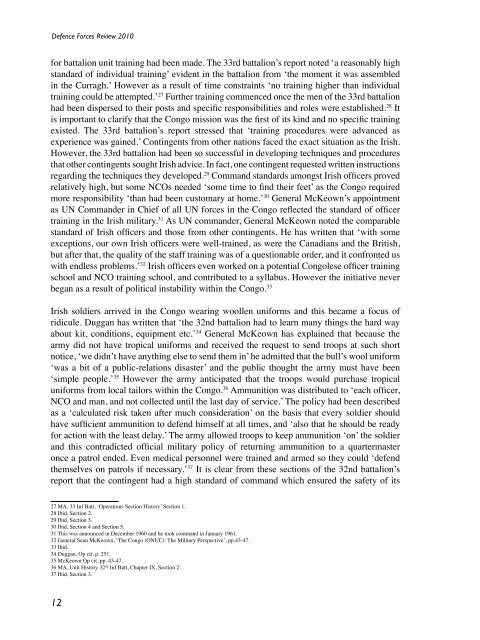Defence Forces Review 2010
Defence Forces Review 2010
Defence Forces Review 2010
You also want an ePaper? Increase the reach of your titles
YUMPU automatically turns print PDFs into web optimized ePapers that Google loves.
<strong>Defence</strong> <strong>Forces</strong> <strong>Review</strong> <strong>2010</strong>for battalion unit training had been made. The 33rd battalion’s report noted ‘a reasonably highstandard of individual training’ evident in the battalion from ‘the moment it was assembledin the Curragh.’ However as a result of time constraints ‘no training higher than individualtraining could be attempted.’ 27 Further training commenced once the men of the 33rd battalionhad been dispersed to their posts and specific responsibilities and roles were established. 28 Itis important to clarify that the Congo mission was the first of its kind and no specific trainingexisted. The 33rd battalion’s report stressed that ‘training procedures were advanced asexperience was gained.’ Contingents from other nations faced the exact situation as the Irish.However, the 33rd battalion had been so successful in developing techniques and proceduresthat other contingents sought Irish advice. In fact, one contingent requested written instructionsregarding the techniques they developed. 29 Command standards amongst Irish officers provedrelatively high, but some NCOs needed ‘some time to find their feet’ as the Congo requiredmore responsibility ‘than had been customary at home.’ 30 General McKeown’s appointmentas UN Commander in Chief of all UN forces in the Congo reflected the standard of officertraining in the Irish military. 31 As UN commander, General McKeown noted the comparablestandard of Irish officers and those from other contingents. He has written that ‘with someexceptions, our own Irish officers were well-trained, as were the Canadians and the British,but after that, the quality of the staff training was of a questionable order, and it confronted uswith endless problems.’ 32 Irish officers even worked on a potential Congolese officer trainingschool and NCO training school, and contributed to a syllabus. However the initiative neverbegan as a result of political instability within the Congo. 33Irish soldiers arrived in the Congo wearing woollen uniforms and this became a focus ofridicule. Duggan has written that ‘the 32nd battalion had to learn many things the hard wayabout kit, conditions, equipment etc.’ 34 General McKeown has explained that because thearmy did not have tropical uniforms and received the request to send troops at such shortnotice, ‘we didn’t have anything else to send them in’ he admitted that the bull’s wool uniform‘was a bit of a public-relations disaster’ and the public thought the army must have been‘simple people.’ 35 However the army anticipated that the troops would purchase tropicaluniforms from local tailors within the Congo. 36 Ammunition was distributed to ‘each officer,NCO and man, and not collected until the last day of service.’ The policy had been describedas a ‘calculated risk taken after much consideration’ on the basis that every soldier shouldhave sufficient ammunition to defend himself at all times, and ‘also that he should be readyfor action with the least delay.’ The army allowed troops to keep ammunition ‘on’ the soldierand this contradicted official military policy of returning ammunition to a quartermasteronce a patrol ended. Even medical personnel were trained and armed so they could ‘defendthemselves on patrols if necessary.’ 37 It is clear from these sections of the 32nd battalion’sreport that the contingent had a high standard of command which ensured the safety of its27 MA, 33 Inf Batt, ‘Operations Section History’ Section 1.28 Ibid, Section 2.29 Ibid, Section 3.30 Ibid, Section 4 and Section 5.31 This was announced in December 1960 and he took command in January 1961.32 General Sean McKeown, ‘The Congo (ONUC): The Military Perspective’, pp.43-47.33 Ibid.34 Duggan, Op cit, p. 251.35 McKeown Op cit, pp. 43-47.36 MA, Unit History 32 nd Inf Batt, Chapter IX, Section 2.37 Ibid, Section 3.12
















